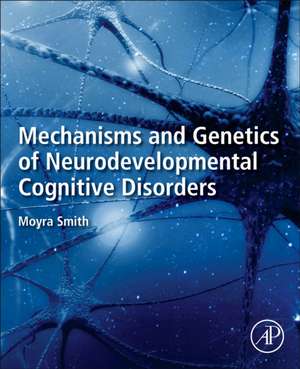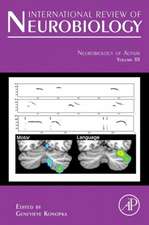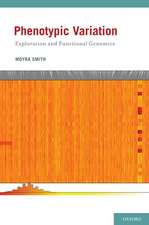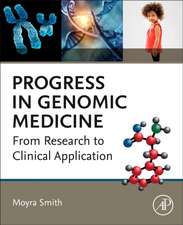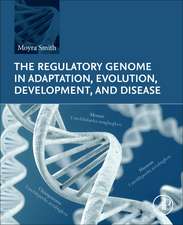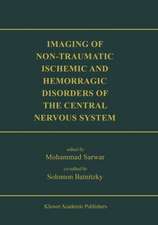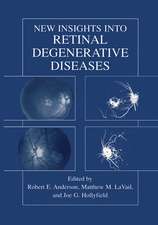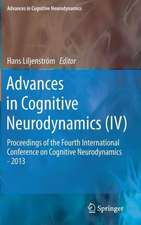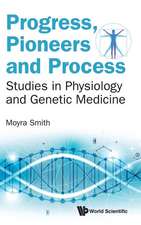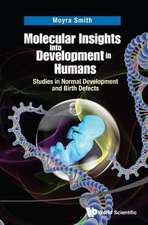Mechanisms and Genetics of Neurodevelopmental Cognitive Disorders
Autor Moyra Smithen Limba Engleză Paperback – 29 apr 2021
This book will promote understanding of recent investigations and developments related to brain development from fetal life onward with specific relevance to neurodevelopmental cognitive disorders and conditions. This is an essential reference for anyone who is looking to learn more about different aspects of neurodevelopment and emerging concepts in psychiatric disorders.
- Discusses links between brain development, gene expression, and brain function
- Covers neural stem cells, proliferation, migration, differentiation, and neurogenesis
- Includes brain mapping, brain plasticity, epigenetics, neuroimmunology, and more
- Provides insight into causation and brain function in autism, attention deficit disorder, and learning disabilities
- Examines impact of society and environmental factors on mental health
Preț: 691.32 lei
Preț vechi: 902.65 lei
-23% Nou
Puncte Express: 1037
Preț estimativ în valută:
132.28€ • 138.11$ • 109.48£
132.28€ • 138.11$ • 109.48£
Carte tipărită la comandă
Livrare economică 29 martie-12 aprilie
Preluare comenzi: 021 569.72.76
Specificații
ISBN-13: 9780128219133
ISBN-10: 0128219130
Pagini: 306
Dimensiuni: 191 x 235 x 19 mm
Greutate: 0.67 kg
Editura: ELSEVIER SCIENCE
ISBN-10: 0128219130
Pagini: 306
Dimensiuni: 191 x 235 x 19 mm
Greutate: 0.67 kg
Editura: ELSEVIER SCIENCE
Cuprins
Section I Brain, early development cortices, architecture, cell types, connectivity, networks1. Early brain development; 2. Development and evolution of cerebral and cerebellar cortex; 3. White matter development and maturation of connections; 4. Brain size; 5. Emergence of functional architecture; 6. Architectonic mapping beyond Brodman; 7. Neuronal cells organization according to transcription; 8. Association cortices; 9. Cell maps neuronal cell types, classification; 10. Development of network hubs; 11. Functional and structural connectivity; 12. Myelo-architecture; 13. Connectome and network theory; 14. Hubs modules nodes; 15. Microstructure connectomics; 16. Dendrites, dendritic spines, spine patterns; 17. Networks; 18. Distinct metabolic and cytoarchitecture and increased dendritic density in hubs; 19. Oligodendrocytes and astrocytes
Section II Neurotransmitters, Neuromodulators. Synapses20. Neurotransmitters and neuroreceptors, neuromodulators; 21. Signalling downstream of receptors; 22. Synapses, structure, diversity; 23. Post-synaptic interactome; 24. Dendrites and transmission; 25. Ion channels and channel dynamics; 26. Lipids and synaptic function
Section III. Brain Mapping27. Mapping structural connections forms of imaging; 28. Functional connectivity and brain metabolic activity; 29. Receptor autoradiography; 30. NIH Connectome project
Section IV. Brain Plasticity31. Neuroplasticity; 32. Brain derived neurotrophic factors; 33. Dendritic spine dynamics and synaptic plasticity; 34. Oligodendrocyte lineage and brain plasticity; 35. Mitochondria and brain energy; 36. Metabolism and circadian rhythm
Section V. Gene Expression and Regulation in Brain and Epigenetics37. Signalling pathways; 38. Gene transcription; 39. Epigenetics and regulation of expression; 40. 3D genome and regulation chromatin modifications and dynamics; 41. Epigenetics, environmental factors; 42. Genomic imprinting and defects potentially impacting development; 43. Genomic regulatory elements and transcription
Section VI. Neuroimmunology44. Neuro-immunology past present and future; 45. Brain immune system; 46. Micro glia and functions related to immune functions; 47. Cytokines and neuromodulators; 48. Defined neuroimmune diseases
Section VII. Neurodevelopmental, Neurocognitive and Behavioral Disorders49. ICD 11 DSM 6 Classification of Pediatric disorders; 50. Neuronal activity post-natal neurogenesis and gliogenesis; 51. Genomic copy number variants in autism and in neurocognitive disorders Genotype phenotype correlation i 52. copy number disorders; 53. Early brain and behavior and development in autism; 54. Functional brain connectome in autism; 55. Idiopathic autism, studies in derived in pluripotent stem cell derived neurons; 56. Gene sequence studies and genome wide association studies in autism; 57. Autism genetic and phenotypic heterogeneity; 58. Specific genetic defects and Syndromic autism spectrum disorders; 59. Non-syndromic autism rare variants; 60. Common variants that impact risk in autism spectrum disorders; 61. Beyond the exome Noncoding genome and enhancers in neurodevelopment; 62. Regulatory elements in neurodevelopmental disorders; 63. Chromosome 22q11.2 microdeletion and microduplication and consequent disorders; 64. Attention deficit disorders risk variants; 65. Cross over in neurobehavioral disorders; 66. Intellectual disability inborn errors of metabolism impacting risk nuclear and mitochondrial defects; 67. Therapeutic advances
Section VIII Psychiatric diseases68. DSM and ICD classifications on basis of clinical manifestations; 69. Architectural and cellular elements in psychiatric disorders; 70. Connectome disruptions in psychiatric diseases; 71. Shared heritability in psychiatric disorders; 72. NIH brain initiative; 73. Future of Psychiatry; 74. Treatment of Psychiatric disorders medications, Neurobehavioral therapy; 75. Microbiome and potential gut brain interactions; 76. Neuromodulation techniques; 77. Ethics and Neuroethics in the Brain Initiative
Section IX Health and Wellbeing78. Environmental factors and epigenetics; 79. Nutritional Deficiencies; 80. Environment and Stress systems involved in stress responses; 81. Social Cognition; 82. Ecosystem Ecotherapy; 83. Enhancing Neuroplasticity, promoting Resilience
Section X Brain and Mind84. Concepts and Ideas; 85. Environment, Learning, Experience; 86. Cultures and Societies
Section II Neurotransmitters, Neuromodulators. Synapses20. Neurotransmitters and neuroreceptors, neuromodulators; 21. Signalling downstream of receptors; 22. Synapses, structure, diversity; 23. Post-synaptic interactome; 24. Dendrites and transmission; 25. Ion channels and channel dynamics; 26. Lipids and synaptic function
Section III. Brain Mapping27. Mapping structural connections forms of imaging; 28. Functional connectivity and brain metabolic activity; 29. Receptor autoradiography; 30. NIH Connectome project
Section IV. Brain Plasticity31. Neuroplasticity; 32. Brain derived neurotrophic factors; 33. Dendritic spine dynamics and synaptic plasticity; 34. Oligodendrocyte lineage and brain plasticity; 35. Mitochondria and brain energy; 36. Metabolism and circadian rhythm
Section V. Gene Expression and Regulation in Brain and Epigenetics37. Signalling pathways; 38. Gene transcription; 39. Epigenetics and regulation of expression; 40. 3D genome and regulation chromatin modifications and dynamics; 41. Epigenetics, environmental factors; 42. Genomic imprinting and defects potentially impacting development; 43. Genomic regulatory elements and transcription
Section VI. Neuroimmunology44. Neuro-immunology past present and future; 45. Brain immune system; 46. Micro glia and functions related to immune functions; 47. Cytokines and neuromodulators; 48. Defined neuroimmune diseases
Section VII. Neurodevelopmental, Neurocognitive and Behavioral Disorders49. ICD 11 DSM 6 Classification of Pediatric disorders; 50. Neuronal activity post-natal neurogenesis and gliogenesis; 51. Genomic copy number variants in autism and in neurocognitive disorders Genotype phenotype correlation i 52. copy number disorders; 53. Early brain and behavior and development in autism; 54. Functional brain connectome in autism; 55. Idiopathic autism, studies in derived in pluripotent stem cell derived neurons; 56. Gene sequence studies and genome wide association studies in autism; 57. Autism genetic and phenotypic heterogeneity; 58. Specific genetic defects and Syndromic autism spectrum disorders; 59. Non-syndromic autism rare variants; 60. Common variants that impact risk in autism spectrum disorders; 61. Beyond the exome Noncoding genome and enhancers in neurodevelopment; 62. Regulatory elements in neurodevelopmental disorders; 63. Chromosome 22q11.2 microdeletion and microduplication and consequent disorders; 64. Attention deficit disorders risk variants; 65. Cross over in neurobehavioral disorders; 66. Intellectual disability inborn errors of metabolism impacting risk nuclear and mitochondrial defects; 67. Therapeutic advances
Section VIII Psychiatric diseases68. DSM and ICD classifications on basis of clinical manifestations; 69. Architectural and cellular elements in psychiatric disorders; 70. Connectome disruptions in psychiatric diseases; 71. Shared heritability in psychiatric disorders; 72. NIH brain initiative; 73. Future of Psychiatry; 74. Treatment of Psychiatric disorders medications, Neurobehavioral therapy; 75. Microbiome and potential gut brain interactions; 76. Neuromodulation techniques; 77. Ethics and Neuroethics in the Brain Initiative
Section IX Health and Wellbeing78. Environmental factors and epigenetics; 79. Nutritional Deficiencies; 80. Environment and Stress systems involved in stress responses; 81. Social Cognition; 82. Ecosystem Ecotherapy; 83. Enhancing Neuroplasticity, promoting Resilience
Section X Brain and Mind84. Concepts and Ideas; 85. Environment, Learning, Experience; 86. Cultures and Societies
